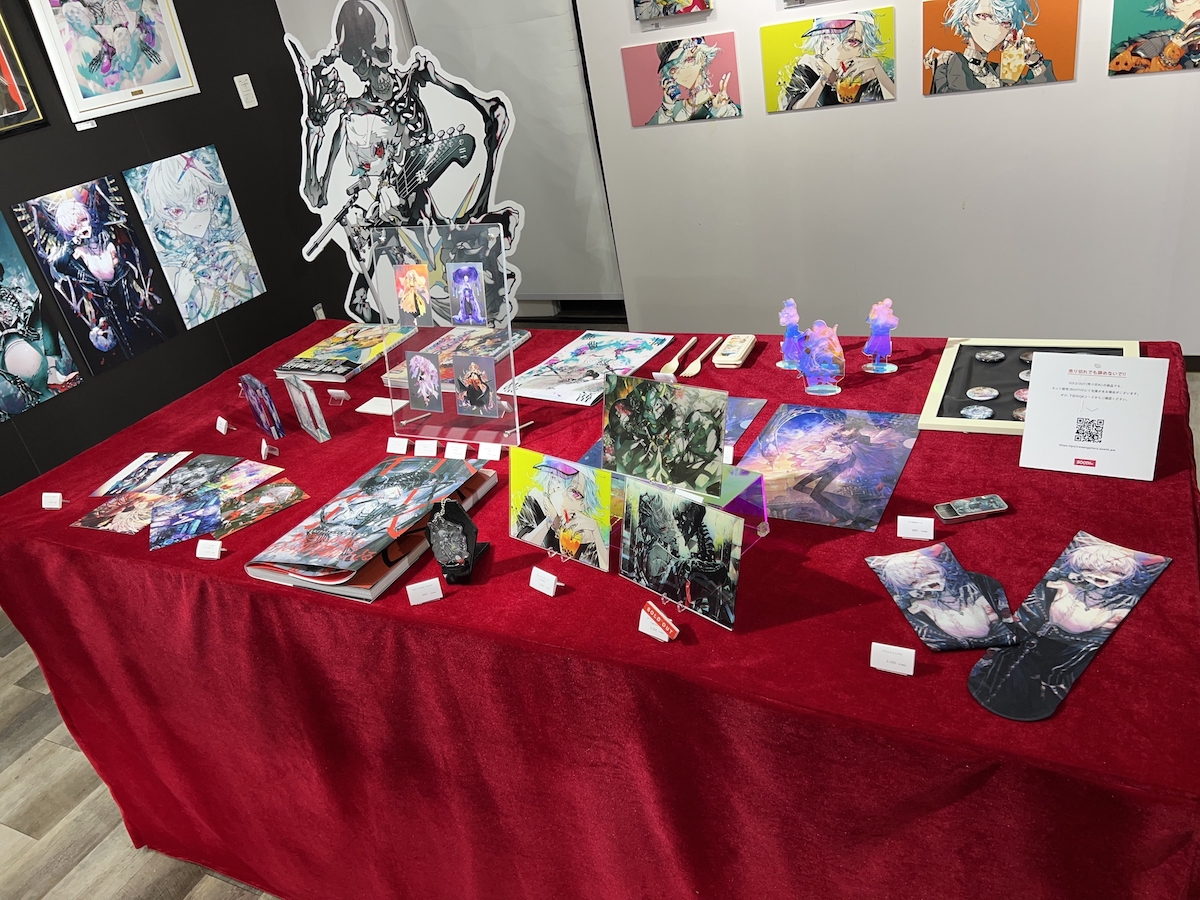“好き”を否定され続けてきたから今がある。イラストレーター・村カルキ、“反骨の半生”を振り返る
インタビュー/阿部裕華
イラストレーター村カルキさんの個展「我」が、東京・表参道にある「pixiv WAEN GALLERY」にて2023年4月26日(水)まで開催中です。新作画集『村カルキ画集 我』の発売を記念し、同画集のイラストを中心に約90点のイラストを展示。これまでの創作活動を振り返る内容となっています。

鮮やかな色彩とこだわりの世界観で“魅せる”村カルキさんのイラストの原点、創作活動の軌跡に迫るとともに、それらの集大成である初画集&初個展「我」に込めた思いをお聞きしました。
イラストレーターの原点は姉
── 村カルキさんが絵を描き始めたきっかけはお姉さんの影響だったと拝見しました。

物心ついた時には息をするように絵を描いていたので、明確なきっかけは覚えてないのですが、姉がマンガ・アニメ・ゲームがすごく好きな人で、常に身近にそういったコンテンツがあり、姉は絵も描く人だったので、おそらく姉の真似をして始めたんだろうなと思っています。小学生の時は、『フルーツバスケット』や『アイシールド21』など、好きなマンガのキャラクターを模写したり、オリジナルキャラクターを描いたりしていました。
── 影響を受けたクリエイターさんはいますか?

たくさんいるので絞れないのですが、絞りに絞って、熊倉裕一さん、伊藤悠さん、今石洋之さん、小松崎類さん、タイキさん、米山舞さんはすごく好きで影響を受けています。もともと背景描きだったこともあり、細部まで描き込まれている絵がすごく好きなんですよね。また、90年代の絵柄が好きなので、しっかりデフォルメされたキャラクターデザインに惹かれます。
背景からキャラクターメインへの転身
── 「背景描きだった」とお話が出てきましたが、もともと背景に関心が強かったのでしょうか?

コンシューマーゲームのイメージボードやコンセプトアートを描く人になりたかったんです。ゲーム会社に就職したかったのですが、ずっとアナログで描いていたのと、単純に画力も足りず、専門学校を卒業してから1年半くらいはフリーターをしながら就職活動していました。そんな中、ソーシャルゲーム(以下、ソシャゲ)バブル一歩手前になり、母校にソシャゲのイラスト制作会社の営業さんがいらっしゃって、先生がその方に私のポートフォリオを見せてくださったことをキッカケに、イラスト制作会社への就職が決まりました。
── 現在はキャラクターメインのイラストを描かれていますが、変化のキッカケはなんですか?

当時のソシャゲって、レアなキャラクターほど周りのエフェクトがすごくて、背景がほとんど見えないんですよね。頑張って背景を描いても見えなくなるし、量産しなければいけないから、会社では背景が重要視されなかったんです。このまま続けていても待遇はよくならないと考えて、キャラクターを描いていこうと転身しました。
── ゲーム会社でキャラクターを描く仕事をする選択もあったと思うのですが、そこからなぜフリーのイラストレーターに?

雑誌『SS(スモールエス)』で扉絵を描かせてもらったことがキッカケです。当時の私は90年代くらいの絵が好きだったので絵柄が古くて……会社では「あなたの絵は使い物にならない」とよく言われていました。『SS』には2年くらいイラストを投稿し続けて、大きく掲載してもらえるようになってきた時、「扉絵を描きませんか?」とお声がけいただいて。初めて自分の名義と絵柄で絵の仕事をいただけたことがすごく嬉しかったんですよ。自分の絵は仕事で通用しないと思っていたので、大きな出来事でした。
それまでは実力をつけて大手のコンシューマーゲーム会社に転職することをモチベーションに頑張っていたのですが、『SS』で扉絵を飾らせてもらってからは、フリーのイラストレーターになろうかなと思うようになりました。
── 背景メインからキャラクターメインというのは大きな変化ですが、ご自身としてはすんなり?

根本にはずっと“世界観を描きたい”という思いがあって、それ自体は変わっていないんです。世界観を表現するためのメインが、背景なのかキャラクターなのかというだけで。例えば、背景描きの頃は「場所は森の中の神殿で、ここにセーブポイントがある」と背景の設定を考えていましたが、キャラクターを描くようになってからは「こういう世界にいるからこういう服を着ている」と考えて描いています。
2015年の投稿作品
世界観に合わせた絵作りをする
── 村カルキさんのイラストは、一枚ごとに雰囲気がガラリと変化する印象を受けるのですが、「世界観を考えてから描く」という工程が影響していそうですね。

そうかもしれません。ひとつの世界観に対してシリーズを考えることもあって、例えば昔描いていた「花の擬人化」シリーズなら和風の世界観、ダークで現代的な「ブラック」シリーズは暗い色調と、それぞれに設定を作っています。

── イラストを描く上で特にこだわっている工程はありますか?

── 着彩する上でも自分の使いたい色よりは、世界観に合わせて色を選んでいくのでしょうか。

世界観に合わせた色合いにしていますね。作品によって色にばらつきがあるのは、そのせいでもあります。例えば、ファンタジーの世界観なら白ではなく黄みがかった光の色でファンタジックに仕上げたり、現代や退廃的な世界観なら彩度を落として、影色も色相をずらさずに塗ります。また、ファンアートを描く際にも、その作品の世界観に合わせて意識的に色合いを変えてます。
デジタル移行で一番よかったことは「お金がかからないこと」
── ゲーム会社勤務まではアナログで絵を描いていたとのことですが、アナログの経験がデジタルに生きていると感じた瞬間は?

いろいろな塗り方に対応できることですかね。高校は美術コースで、いろんな画材を使って作品を作っていました。私自身もアナログで描くのが好きで、毎月のお小遣いをやりくりして、学校の課題だけでなく趣味でもいろいろな画材に挑戦していました。コピック、水彩、アクリルガッシュ、油絵、パステル、顔彩、エアブラシ、ポスターカラーなど、今あげた画材であれば使える能力があったので、会社で水彩塗り、アニメ塗り、厚塗りと、テイスト違いの塗り方を求められた時、ある程度どんな塗り方でも対応できたんです。会社でよく「絵が使いものにならない」と言われていましたが、着彩や背景の力があったので、なんとかクビにならなくてすんだのかなと思っています。
── 逆にアナログからデジタルに移行してよかったと思うことはありますか?

“コスパのよさ”ですね。フリーターから会社員、またフリーランスになってからの数年も、本当にお金がなくて食べるものにも困る状態で、とてもじゃないですけど画材は買えませんでした。ゲーム会社に入るためにデジタル移行しましたが、その時にデジタルに移行していなかったら、カラーイラストが描けていなかったかもしれません。
── ソフトとペンタブを揃えるのにお金はかかりますけど、揃ってしまえば基本的にお金はかかりませんもんね。

そうなんですよ。アナログでは水彩絵の具やアクリルガッシュをメインに描いていたのですが、絵の具が1本数百円とかするんですよね。色によっても値段が変わりますし、画材を買う時、「もう少し安かったら」「今月は無理だけど来月はこれを買うんだ」と思っていました。デジタルだと壊れない限りはどんなに塗り直してもお金はかからないのでコスパがいいなと(笑)。
ただ、アナログは筆や水の量によって一筆置いただけで自然とテクスチャができるのですが、デジタルはブラシ選びや描き方を考えないとすごく味気ない絵になってしまいます。会社ではデジタルで描かなければいけなかったものの、実家に帰ってアナログ絵を描いては「アナログの方が楽しいな」と思っていました(笑)。デジタルに完全移行するのは結局、3〜4年かかりましたね。
── 作業環境を教えていただけますか?

22インチの液タブ、モニターが2台、iPadが1台あります。ソフトはほぼクリスタです。モニターは複数画面表示にして、描いているイラストや全体をチェックしつつ、資料もいっしょに表示しています。iPadは絵を描くために買ったんですけど、ずっと家にいるからiPadで描く必要性がないことが発覚して……最近はもっぱら作業用に海外ドラマやアニメを流しています(笑)。
「自分の技術や知識で、悩んでいる方の役に立ちたい」
── 村カルキさんは、専門学校のゲスト講師や技法書の執筆もされています。学生さんのイラストで「もったいないな」と感じる点はありますか?

キャラクターを描きたい方が多いので、キャラはすごく魅力的に描けているのに、背景や小物、ライティングなどでイラストの見栄えがよくなくなっていることが多いと感じています。
とはいえ、背景を描くハードルの高さも理解できます。だから、『7色のテーマイラストで学ぶ 塗りテクニック』では、写真やテクスチャを使ったりコピペしたりするだけで簡単にクオリティアップできるような描き方を紹介しています。例えば、難しい印象のある木漏れ日も、乗算で色を塗って光を抜いていくという少しの工夫で簡単に描けるし、そうするとイラスト全体の見栄えが良くなるんですよ。絵にかけられる時間や情熱は人によって様々ですし、簡単に楽しくいい絵が描けたらと思いながら技法書を作りました。
発売中の『7色のテーマイラストで学ぶ 塗りテクニック』(ホビージャパン)
── 講師や技法書の執筆など、教える仕事に積極的なのは理由があるのでしょうか?

ネガティブな話になってしまうのですが、私は物覚えが悪くて、いろんな人から「あなたはこんなこともできないの?」と怒られてきたんですよ。人より何倍も頑張らなきゃいけなかったし、頑張ったとしても怒られて委縮して、余計にできなくなることもありました。だからこそ私ができることを考えた時、“どんな人にも分かりやすく教えること”はできるなと。そして私は楽しくないと続かない性格なので、簡単かつ楽しく伝えられるだろうと。怒られて傷ついてきた経験があるからこそ、私と似た境遇の方を傷つけずに教えられると考えて、技術書の執筆や専門学校の講師を積極的にしています。
人には得手不得手があります。誰かがすぐできてしまうことが、誰かにとっては数年、数十年かかる場合もありますし、一生できない場合もあります。ですが、自分ができること=人も当たり前にできることだと考える人も少なくありません。そうなってくると、「どうしてこんなこともできないんだ」となってしまうんですね。
私はずっと「どうしてこんなこともできないんだ」と言われる側でした。ただ、私は言われる側だったからこそ、ずっと続けてきた絵であれば、どうしてできないのか、逆にどういう風に伝えたら楽しく上手くできるのかが分かります。なので、自分の持つ技術や知識を共有して、悩んでいる方の役に立ちたいと思っています。
── 苦い経験を推進力に変えられていて素晴らしいです。3月には新しい技法書『美少年の描き分け 塗りテクニック』が発売されましたが、既刊の『7色のテーマイラストで学ぶ 塗りテクニック』とはどのような違いがあるのでしょう?

『7色のテーマイラストで学ぶ 塗りテクニック』は見栄えをよくするための色使いや簡単に背景の情報量を増やす方法に重きを置いていましたが、『美少年の描き分け 塗りテクニック』では“美少年”がテーマなのでキャラクターをうまく描くコツや、情報量を操作してキャラにより焦点があたる描き方、考え方を紹介しています。

以前はできる限り多くの情報量を詰め込む描き方だったのですが、今は情報を詰めるところと抜くところを考える描き方に変わったので、それは大きな違いかもしれません。よりキャラクターに視点が当たるような描き方を学べるのではないかと思います。
自分の好きを好いてくれた人たちへ、感謝を込めた“我”
── ここからは個展「我」についてのお話をお聞かせください。4月18日発売の新作画集『我』と連動した個展ですが、「我」というタイトルにした理由はなんですか?

「私の好きなものを好いてくれてありがとうございます」という感謝を込めて付けました。
── 感謝、ですか?

私は小さい頃から絵を描いてきましたが、よくある「人に絵をほめられて嬉しかったから絵が好きになった」といったエピソードは一切ないんですよ。近所の子に「お姉ちゃんの方が絵が上手いから、村ちゃんの絵はいらない」と言われたり、周りにも上手い人がたくさんいたのでけなされたり、「ここおかしい」と言われたりすることはあれど、小中高とほめられた記憶はあまりありません。それに、昔からニッチなものが好きだったので、「なんでこんなものが好きなの?」とたくさん言われてきました。小さい頃からずっと自分の好きなものを否定されて生きてきたので、自分の好きなものを出すのが嫌になったんです。「こっちの方がみんなが好きだから、こっちにした方がいい」とも言われたこともあります。
ですが、みんなが「いい」と思うものを必ずしも自分が「いい」と思う必要はないと思い続けてきました。当時はSNSがなかったのであまり人に見せることもなかったですし、唯一私は私の好きなものを描いても否定されない場所が「絵」で、私がほめられなくてもひたすら絵を描いてきたのは、自分の好きなものを表現するためなんです。
それからネットやSNSにイラストを投稿することが当たり前の時代になり、なかなか人気が出ず苦労しましたが、自分の「好き」は好かれにくい、ならどうすれば好かれやすくなるのかを研究して、運よくいろんな人に見てもらえて、仕事をいただけて、画集や個展の機会までいただけた。自分の好きを貫いてきて、それを好きになってくれた人がいた、『我』はそれらに対する感謝なんです。
── 画集の表紙や個展のメインビジュアルも、村カルキさんの「好き」が詰め込まれているのでしょうか。

画集の担当さんにどんな表紙がいいかを聞いたところ、「好きに描いていいです」と言ってくださったので、いつも描いている「ブラック」シリーズから自分の好き100%で描かせていただきました。表紙だから万人受けを狙いたいとも最初は思ったのですが、「そもそも万人受けが分からない」と思い、背景が描き込まれた絵が昔からすごく好きなので、小さい頃の私が見て喜びそうな背景が描きこまれた絵を描きました。
また、書店の画集コーナーにはカラフルで煌びやかな表紙が多いので、モノトーンと赤で描くことで、そこだけ異質な空間として目立てばいいなと。個展のメインビジュアルも同じです。開催場所の表参道ってシンプルでキレイな街並みの印象があったので、こちらはモノトーンだと目立たないかもと思い、背景を真っ赤にして浮くような雰囲気を出せたらと思いました。「あそこ、めっちゃ赤い!」と目に入ってくれたら嬉しいですね(笑)。
── 個展の中で特に注目してほしいポイントはありますか?

等身大の真っ黒なガイコツが飾られているので、ぜひ見てほしいです。シルバーアクセサリーのブラックコーティングが好きでイラストによく描いていることもあり、ワガママを言って用意していただいたのですが、想像したよりも存在感と迫力がすごかったです。整骨院や整体などで等身大の骨格模型を見る機会はあっても、黒く塗装された骨を見る機会はないので(笑)。
── インパクトがすごそうですね(笑)。グッズはいかがでしょう?

層が重なったレイヤードアクリルは、あまり見たことがないので楽しみですね。個展用に描き下ろしたイラストのグッズもあるのでぜひお手に取っていただければ。以前「pixiv WAEN GALLERY」に行った時に、どのグッズも印刷がとてもキレイだったので、いろいろ見てほしいです。


Twitterで個展の感想を呟いてくださった方には、ギターピックを無料配布するんですが、それがめっちゃカッコいいんですよ。感想を強要するわけではないのですが(笑)、せっかく無料でもらえるので、ぜひTwitterに感想を呟いてゲットしてください。
── 最後に今後の活動の展望をお聞かせください。

もともとコンシューマーゲームの会社に入りたかったので、背景でもキャラクターでもデザイン面でもお力になれることがあれば、コンシューマーゲームのお仕事がしたいですね。
また、VTuberさんやVシンガーさんから依頼をいただいてから配信を見たり歌を聴いたりする機会が増え、今では趣味になったので、VTuberさんやVシンガーさんのキャラクターデザインもやりたいです。ほかにも、やらせてもらえる案件があれば積極的に仕事の幅を広げていきたいなと思ってます。
4月26日(水)まで開催中! 村カルキ初個展「我」
pixivとツインプラネットが共同運営するギャラリー「pixiv WAEN GALLERY by TWINPLANET × pixiv」にて、村カルキさん初個展「我」が4月26日(水)まで開催中です。
村カルキさんのこれまでの作品から、厳選された約90点を展示します。ビッグサイズのタペストリーやアクリルアートの他に、村カルキさんがお好きなモチーフだという黒ガイコツが等身大で登場します。
開催期間:2023年4月7日(金)〜4月26日(水)
定休日:なし
入場無料
所在地:東京都渋谷区神宮前5-46-1 TWIN PLANET South BLDG. 1F
営業時間:12:00~19:00
※新型コロナウイルス感染症の予防のための対策について
pixiv WAEN GALLERYでは厚生労働省のガイドライン等を参考にした新型コロナウイルス感染症の予防対策を行い、ギャラリーにご来場されるお客様の安全に配慮した上で営業しています。ギャラリーにご来場されるお客様におかれましては、感染防止の徹底にご理解とご協力を賜りますようお願いします。 対策について詳しくは、展示情報をご覧ください。感染拡大の状況を鑑み、営業について変更が生じる場合は、pixiv WAEN GALLERY公式WEB、公式Twitterにてお知らせします。
一部グッズはWEB販売も!
BOOTHにて個展販売グッズの一部をご購入いただけます。美麗なタペストリーやかわいいアクリルスタンドに加えて、村カルキさん監修のチョーカーなど、さまざまな商品を揃えておりますので、ぜひ覗いてみてください。












